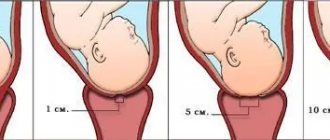Why is Utrozhestan prescribed to pregnant women?
The successful course of pregnancy largely depends on sufficient levels of progesterone, a hormone that supports fetal development. After conception, it is produced by a temporary endocrine gland - the corpus luteum at the site of the released egg. Progesterone prepares the walls of the uterus for implantation of the fertilized egg and causes thickening of the cervical mucus, which prevents infection from entering the uterus.
From the 16th week of pregnancy, progesterone production is assigned to the placenta. With insufficient production of the hormone, a pathology such as ICI occurs. In this case, the expectant mother may observe spotting, which indicates a threat of miscarriage. A short cervix is diagnosed during an ultrasound. After it, the expectant mother is hospitalized and treatment is prescribed to prevent spasms and dilatation of the uterus, and increase the elasticity of the cervix.
Utrozhetan is prescribed to pregnant women not only for a short cervix. Indications for its use are conditions associated with a lack of progesterone:
- fibroids, fibroids;
- bloody issues;
- uterine tone;
- prevention of the threat of miscarriage;
- pregnancy through IVF;
- pregnancy with luteal phase deficiency;
- spontaneous abortions, history of premature birth.
How does the drug affect the body of the expectant mother and the fetus?
Utrozhestan is produced in the form of capsules and vaginal suppositories, which are normally tolerated by the expectant mother and do not affect the development of the baby. The drug does not change the production of female hormones and does not cause excess weight gain. It does not affect the hormonal system of the fetus, but it helps many women carry a child to term and give birth on time.
There are numerous reviews of mothers for whom Utrozhestan helped to bear a child with uterine tone, fibroids, and cervical pathologies (including a short cervix). This is a highly effective drug that helps well with an imbalance of female hormones in the body. At the same time, it is important to take the capsules correctly, only under the supervision of an obstetrician-gynecologist.
How to take the drug for a shortened cervix and other pathologies?
The dosage and method of taking the hormonal drug are prescribed by the doctor. It relies on information about the patient’s condition and takes into account the severity of progesterone deficiency in her body. Reception should be carried out strictly according to the instructions. Typically one of the following regimens is prescribed:
- Orally 200-300 mg in several doses. The morning dose can be 100 mg, the rest the pregnant woman drinks during the day.
- If there is a threat of miscarriage, you should take 400 mg at a time and repeat every 7-8 hours until the condition stabilizes under the supervision of a doctor. After improvement, reduce the daily dose to 200 mg. Take the medicine until 36 weeks.
- For vaginal administration of suppositories, the daily dose is 200 mg. If necessary, the doctor will decide to increase the intake to 400 ml or more.
- If there is a threat of premature birth, the drug is prescribed in the period from 22 to 36 weeks at a dosage of 200-400 ml every 12 hours.
- In the early stages (up to 12 weeks), the optimal dose for maintaining pregnancy is 100-200 mg per day. If pregnancy occurs as a result of IVF, it is increased to 300-600 mg.
Overdose
Symptoms: drowsiness, transient dizziness, euphoria, shortening of the menstrual cycle, dysmenorrhea.
In some patients, the average therapeutic dose may be excessive due to existing or emerging unstable endogenous secretion of progesterone, special sensitivity to the drug, or too low concentration of estradiol.
- in case of drowsiness or dizziness, it is necessary to reduce the daily dose or prescribe the drug before bedtime for 10 days of the menstrual cycle;
- in case of a shortening of the menstrual cycle or spotting, it is recommended to postpone the start of treatment to a later day of the cycle (for example, on the 19th instead of the 17th);
- in perimenopause and with postmenopausal MHT, it is necessary to ensure that the concentration of estradiol is optimal.
In case of overdose, symptomatic treatment is carried out if necessary.
Utrozhestan for ICN during pregnancy
Not only surgery can solve the problem of premature birth. To significantly reduce the likelihood of miscarriage, special medications may be prescribed. ICN and Utrozhestan are connected for a large number of different reasons.
Indications for the use of such a drug are as follows:
- If there is a threat of premature birth. ICN in Utrozhestan manifests itself less, but still cannot be avoided without surgical intervention.
- The threat of spontaneous abortion or miscarriage, which is associated with indications obtained during the study or from the anamnesis. If a woman has had several miscarriages, then the ICN is carried out in Utrozhestan.
- Very often, muscle failure develops against the background of a hormonal disorder. The drug in question is used to normalize hormonal levels, thereby reducing the likelihood of fetal loss.
Utrozhestan for ICN during pregnancy: features of the effect and form of release of the drug
Utrozhestan should be taken for ICN only as prescribed by a doctor. It should be taken into account that the hormone progesterone is used in the manufacture of the drug. This substance creates the most favorable conditions for conception, and also allows you to preserve the fetus during gestation. Utrozhestan for ICI during pregnancy is used due to its fairly high efficiency, as well as for the following reasons:
- The drug is produced in the form of suppositories; it may have different pharmacokinetics depending on the characteristics of administration.
- If suppositories are taken orally, the effect of the drug begins in the gastrointestinal tract. Drugs are excreted after exposure to urine.
- Vaginal administration is characterized by rapid adsorption. In this case, the main active substance accumulates in the uterus, which ensures the greatest effectiveness of the drug.
- As studies have shown, the highest concentration of the active substance is recorded after an hour from the moment of administration of the product.
- When the drug is administered in an amount of 200 mg per day, the concentration of progesterone corresponds to the first trimester of pregnancy.
- The drug in question is produced in the form of capsules, which only open in the body. The appearance is represented by an elongated capsule with a white color. The drug is available in capsules with a concentration of 200 milligrams.
In case of ICN, when to discontinue Utrozhestan should be decided solely by the doctor, since a decrease in the concentration of the female hormone can lead to a large number of problems. Also, the point at which Utrozhestan for ICN should be used until which week should be decided by the doctor.
Pharmacokinetics
When taken orally
Micronized progesterone is well absorbed from the gastrointestinal tract. The concentration of progesterone in the blood plasma gradually increases during the first hour, Cmax in the blood plasma is observed 1-3 hours after administration. The concentration of progesterone in the blood plasma increases from 0.13 ng/ml to 4.25 ng/ml after 1 hour, to 11.75 ng/ml after 2 hours and is 8.37 ng/ml after 3 hours, 2 ng/ml after 6 hours and 1.64 ng /ml - 8 hours after administration.
The main metabolites that are detected in blood plasma are 20-alpha-hydroxy-delta-4-alpha-pregnanolone and 5-alpha-dihydroprogesterone.
It is excreted in the urine in the form of metabolites, 95% of which are glucurone-conjugated metabolites, mainly 3-alpha, 5-beta-pregnanediol (pregnandione). These metabolites, which are determined in blood plasma and urine, are similar to substances formed during the physiological secretion of the corpus luteum.
With intravaginal administration
Suction and distribution
Absorption occurs quickly, a high concentration of progesterone is observed 1 hour after administration. Cmax of progesterone in blood plasma is achieved 2-6 hours after administration. When the drug is administered at a dose of 100 mg 2 times a day, the average concentration remains at the level of 9.7 ng/ml for 24 hours. When administered in doses of more than 200 mg/day, the concentration of progesterone corresponds to the first trimester of pregnancy.
Plasma protein binding is 90%. Progesterone accumulates in the uterus.
Metabolized to form predominantly 3-alpha, 5-beta-pregnanediol. The concentration of 5-beta-pregnanolone in the blood plasma does not increase.
It is excreted in the urine in the form of metabolites, the main part being 3-alpha, 5-beta-pregnanediol (pregnandione). This is confirmed by a constant increase in its concentration (Cmax 142 ng/ml after 6 hours).
How to take Utrozhestan for ICN?
It is worth considering that the dosage of Utrozhestan for ICI is selected depending on the characteristics of the woman’s condition. There are several ways to use the drug, which will be discussed in more detail below.
The oral route of drug administration has the following features:
- The medicine is taken orally, after which it is washed down. It is made in the form of capsules with a shell. Therefore, no unpleasant taste is felt during administration.
- In many cases, the doctor prescribes a daily dose of 200-300 mg; it is recommended to separate the dose in the morning and evening.
- If there is a high risk of miscarriage or premature pregnancy, the daily dose can be increased to 200-600 mg.
- Further use of the drug as prophylaxis is possible only as prescribed by a doctor.
- It is possible to use the drug to normalize hormonal levels. In this case, the daily dose does not exceed 200 mg, and the period of use is 10-12 days.
In addition, there is a vaginal method of introducing capsules. To do this, they are inserted deep into the vagina. Among the features of this method of drug administration, the following points can be noted:
- The dosage can range from 200 to 500 mg per day. Divide the drug intake into three doses.
- The dosage may vary depending on the condition of the mother.
- Further use of the drug is possible only as prescribed by a doctor based on clinical data. An example is the level of progesterone in the blood.
Cancellation of Utrozhestan in ICI can be carried out for a variety of reasons. An example is the development of side effects:
- An allergic reaction develops against the background of an increase in the concentration of certain substances.
- When taking the drug orally, drowsiness or transient dizziness may occur, which should subside in approximately 1-3 hours.
In most cases, an overdose causes side effects. By reducing the dosage, many side effects should disappear. Reviews about Utrozhestan for ICN indicate that other side effects often do not develop.
Considering the application features, we will pay attention to the following points:
- This drug is not recommended for use as a contraceptive.
- Please note that the drug may have an effect on the liver. Therefore, if furnace dysfunction is observed, the drug should be taken with caution.
- When taking the drug orally, you need to be careful when driving. This is due to the fact that drowsiness or weakness may occur. In addition, you should not engage in complex or dangerous work.
The above dosage information is only the most common cases. In order to reduce the likelihood of developing side effects, the dosage and regimen should be prescribed by the attending physician. It is worth remembering that taking the medicine incorrectly can cause miscarriage or other problems. In some cases, the drug in question is not prescribed at all due to the fact that it can have a negative effect on the body of the expectant mother.
How to properly stop the drug?
To avoid sudden hormonal imbalance, Utrozhestan should be discontinued gradually. The daily dose is reduced weekly to 100 ml. During this period, it is important for a woman to closely monitor her condition. She shouldn't be bleeding. Depending on the dosage the expectant mother takes the drug, withdrawal from it lasts 3-6 weeks.
Progesterone is one of the key hormones that ensures the onset and maintenance of pregnancy. Even before fertilization, it causes decidual transformations of the endometrium and prepares it for implantation, promotes the growth and development of the myometrium, its vascularization, and stimulates the growth and development of the mammary glands.
Progesterone is one of the key hormones that ensures the onset and maintenance of pregnancy. Even before fertilization, it causes decidual transformations of the endometrium and prepares it for implantation, promotes the growth and development of the myometrium, its vascularization, and stimulates the growth and development of the mammary glands.
The incidence of abortion, according to various authors, is 10–20%, with 75–80% of them occurring in the first half. Hormonal insufficiency of the ovaries and placenta is one of the most common causes of pregnancy loss. In 64–89% of cases, the main pathogenetic mechanism of miscarriage is progesterone deficiency or a decrease in the receptivity of the uterus and appendages to the action of this hormone. Therefore, treatment of threatened abortion in the first half of pregnancy should be aimed primarily at replenishing the lack of progesterone.
Numerous studies have proven the pathogenetic validity of the administration of progesterone in cases of threatened miscarriage.
Currently, the search continues for optimal drugs based on progesterone and its derivatives, which could be used in obstetrics from early pregnancy and meet high requirements for efficiency, safety and ease of use.
Micronized progesterone - Utrozhestan - is successfully used in the complex treatment of threatened miscarriage in the first half. One of the main advantages of this drug is the possibility of both oral administration and vaginal administration. This dosage form was created to achieve better biological absorption. According to research results, natural micronized progesterone is absorbed quickly and in sufficient quantities. It has been proven that when administered vaginally, the concentration of progesterone in the endometrium increases significantly due to the initial passage of the drug through the uterus.
It should be noted some features of the effect of Utrozhestan on the maternal body and fetus, which constitute its advantage over synthetic analogues. Utrozhestan does not have antigonadotropic activity, androgenic, estrogenic and glucocorticoid properties. It does not affect the lipid profile, blood pressure, carbohydrate metabolism, blood clotting, body weight, and does not cause fluid retention in the body. The main metabolites of Utrozhestan are indistinguishable from the metabolites of endogenous progesterone. When taking the drug, the levels of progesterone metabolites in the blood plasma increase, mainly pregnanediol, pregnanolone, pregnandione, 20α-dihydroprogesterone and 17-hydroxyprogesterone.
As we noted earlier, hormonal disorders are one of the main causes of termination of pregnancy, and the prescription of progesterone as part of complex therapy is undoubtedly pathogenetically justified in these situations. Currently, research is ongoing to optimize the use of progesterone drugs during pregnancy, assess their effectiveness and safety, and their effect on the body of the mother, fetus and newborn.
What is Utrozhestan
Utrozhestan is a medicine with the active ingredient progesterone, produced in the form of yellow, oval-shaped soft gelatin capsules. The contents of the capsules are an oily, whitish homogeneous suspension, without visible phase separation. Belongs to the group of gestagenic agents (gestagen is another name for progesterone).
Appearance (photo) of the drug Utrozhestan
This hormone plays an important role during pregnancy. It changes the structure of the endometrium of the uterus to facilitate the introduction of a fertilized egg into it, reduces uterine contractility, preventing the occurrence of uterine hypertonicity and miscarriage. Progesterone takes part in preparing the mammary glands for breastfeeding, stimulating lactation.
pharmachologic effect
The active ingredient of the drug Utrozhestan ® is progesterone, which is identical to the natural hormone of the corpus luteum of the ovary. By binding to receptors on the surface of cells of target organs, it penetrates into the nucleus, where, activating DNA, it stimulates RNA synthesis.
Promotes the transition of the uterine mucosa from the proliferation phase caused by the follicular hormone estradiol to the secretory phase. After fertilization, it promotes the transition to the state necessary for the development of a fertilized egg. Reduces the excitability and contractility of the muscles of the uterus and fallopian tubes. Promotes the formation of normal endometrium. Stimulates the development of the end elements of the mammary gland, induces lactation.
By stimulating protein lipase, it increases fat reserves and increases glucose utilization. By increasing the concentration of basal and stimulated insulin, it promotes the accumulation of glycogen in the liver and increases the production of gonadotropic hormones of the pituitary gland; reduces azotemia, increases nitrogen excretion in urine.
Indications for use
Utrozhestan is recommended for use in women with progesterone deficiency.
Oral administration of capsules is prescribed in the following cases:
- infertility due to luteal insufficiency;
- prevention of habitual abortion due to progesterone deficiency;
- premenstrual syndrome;
- premenopause;
- disruption of the menstrual cycle due to ovulation disorders or anovulation;
- threatened abortion;
- hormone replacement therapy in perimenopause and postmenopause (together with taking estrogen-containing drugs).
- prevention (prophylaxis) of premature birth in women at risk (with a short cervix and/or anamnestic data of premature birth and/or premature rupture of membranes);
- threatened abortion or prevention of habitual abortion due to progesterone deficiency;
- premature menopause;
- hormone replacement therapy for progesterone deficiency with non-functioning (absent) ovaries (egg donation);
- support of the luteal phase in the process of preparation for IVF;
- luteal phase support in induced or spontaneous menstrual cycle;
- hormone replacement therapy in combination with estrogen-containing drugs;
- infertility due to luteal insufficiency.
Dosage regimen
Oral route of administration
The drug is taken orally, in the evening before bed, with water.
In most cases, with progesterone deficiency, the daily dose of Utrozhestan ® is 200-300 mg, divided into 2 doses (200 mg in the evening before bed and 100 mg in the morning, if necessary).
In case of threatened abortion or to prevent habitual abortion due to progesterone deficiency, 200-600 mg/day is prescribed daily in the first and second trimesters of pregnancy. Further use of the drug Utrozhestan ® is possible as prescribed by the attending physician based on an assessment of the clinical data of the pregnant woman.
In case of luteal phase insufficiency (premenstrual syndrome, fibrocystic mastopathy, dysmenorrhea, menopausal transition), the daily dose of the drug is 200 or 400 mg for 10 days (usually from the 17th to the 26th day of the cycle).
For MHT in perimenopause while taking estrogen, Utrozhestan ® is prescribed at 200 mg/day for 12 days.
For MHT in postmenopause in a continuous mode, the drug Utrozhestan ® is used in a dose of 100-200 mg from the first day of taking estrogen. Dose selection is carried out individually.
Vaginal route of administration
Capsules are inserted deep into the vagina.
Prevention (prophylaxis) of preterm birth in women at risk (with shortening of the cervix and/or history of preterm labor and/or premature rupture of membranes): the usual dose is 200 mg at bedtime, from the 22nd to the 34th week pregnancy.
Complete absence of progesterone in women with non-functioning (absent) ovaries (egg donation): against the background of estrogen therapy, 100 mg/day on the 13th and 14th days of the cycle, then 100 mg 2 times/day from the 15th to On the 25th day of the cycle, from the 26th day and if pregnancy is detected, the dose increases by 100 mg/day every week, reaching a maximum of 600 mg/day, divided into 3 doses. The indicated dose is usually used for 60 days.
Support of the luteal phase during the in vitro fertilization cycle: it is recommended to use from 200 to 600 mg/day, starting from the day of human chorionic gonadotropin injection during the first and second trimesters of pregnancy.
Support of the luteal phase in a spontaneous or induced menstrual cycle, in case of infertility associated with dysfunction of the corpus luteum: it is recommended to use 200-300 mg/day, starting from the 17th day of the cycle for 10 days, in case of delayed menstruation and diagnosis of pregnancy, treatment should to be continued.
In cases of threatened abortion or in order to prevent habitual abortion occurring against the background of progesterone deficiency: 200-400 mg/day in 2 divided doses daily in the first and second trimesters of pregnancy.
Why is Utrozhestan needed during pregnancy?
During pregnancy, experts prescribe Utrozhestan suppositories to pregnant women in the following cases:
- risk of spontaneous abortion (miscarriage);
- low level or deficiency of progesterone in the blood.
If a woman has had miscarriages in the past, then Utrozhestan can be prescribed for prevention. If there is a threat of miscarriage, the medication is used as an emergency.
Other indications for use of the drug in pregnant women include:
- presence of miscarriages in the past;
- complications of pregnancy due to lack of progesterone;
- conception occurred through IVF or the procedure was carried out in the past;
- taking Utrozhestan or its analogues at the time of conception;
- previous pregnancy ended in premature birth;
- infertility was diagnosed due to disruption of the second phase of the menstrual cycle;
- shortened cervix.
These are the main indications for the use of Utrozhestan during pregnancy. In some cases, the drug may be prescribed for other reasons.
Pregnant woman and doctor
Use of Utrozhestan during pregnancy
The use of the drug during pregnancy should occur only after passing all the necessary tests and a doctor’s prescription. The features of using the product at different stages of pregnancy are indicated below.
1st trimester
In the early stages of pregnancy, the drug is allowed and often recommended for use. Capsules are inserted into the vagina daily and at the same time, which avoids harmful effects on the liver and digestive tract. In addition, toxicosis may interfere with oral administration of capsules.
Why is Utrozhestan prescribed in the first trimester:
- prevention and elimination of uterine tone;
- improving the functioning of the nervous system;
- prevention of spontaneous miscarriage;
- replenishment of progesterone deficiency.
How does the drug affect the fetus? Negative impacts are almost completely eliminated. In rare cases, hypospadias (an abnormality of the urethra) may occur. At the same time, it is advisable to minimize the use of any medications at the beginning of pregnancy, since at this time the formation of all systems and organs of the unborn child occurs. That is why the drug should be prescribed by a specialist, based on the condition and tests of the pregnant woman.
2nd trimester
At this stage of pregnancy, taking the drug is usually not necessary. Why is Utrozhestan prescribed in the second trimester of pregnancy? The main indication is a lack of progesterone, among others:
- cervical insufficiency;
- shortening of the cervix;
- pregnancy occurred through in vitro fertilization.
In certain cases, anamnesis can be examined if there have been miscarriages in the past, surgical manipulations on the uterus, childbirth before the due date, Utrozhestan administration is extended indefinitely.
3rd trimester
From the 30th week of pregnancy, Utrozhestan can be prescribed in the following cases:
- short cervix;
- very low position of the child;
- early softening of the birth canal.
Taking Utrozhestan in late pregnancy is justified only if there is a high risk of premature birth. This is due to the fact that taking progestin medications has a detrimental effect on the condition of the liver and poses a particular danger in case of thrombosis.
It is important to understand that the possibility and necessity of taking Utrozhestan is considered individually in each case.
Instructions for use and dosage
The specialist prescribes the method and duration of taking Utrozhestan, based on the degree of progesterone deficiency and the characteristics of pregnancy.
The capsules are taken orally as follows:
- the daily dosage is 200-300 ml, which is taken throughout the day;
- Usually 100 ml of the drug is taken in the morning, and the rest - before bed.
For prevention when there is a threat of premature birth, the drug is taken according to the following scheme:
- 400 ml every 7-8 hours until you feel better;
- 200 ml every 7-8 hours until 36 weeks of pregnancy.
For intravaginal use, the drug is administered into the vagina in a dosage of 200 ml every day. The procedure is carried out while lying on your side, preferably at night, so that the medicine can take full effect.
Drug interactions
When administered orally
Progesterone enhances the effect of diuretics, antihypertensive drugs, immunosuppressants, and anticoagulants.
Reduces the lactogenic effect of oxytocin.
Concomitant use with drugs that induce microsomal liver enzymes CYP3A4, such as barbiturates, antiepileptic drugs (phenytoin), rifampicin, phenylbutazone, spironolactone, griseofulvin, is accompanied by an acceleration of progesterone metabolism in the liver.
Simultaneous use of progesterone with some antibiotics (penicillins, tetracyclines) can lead to a decrease in its effectiveness due to disruption of the enterohepatic recirculation of sex hormones due to changes in the intestinal microflora.
The severity of these interactions may vary in different patients, so predicting the clinical effects of these interactions is difficult.
Ketoconazole may increase the bioavailability of progesterone.
Progesterone may increase the concentration of ketoconazole and cyclosporine.
Progesterone may reduce the effectiveness of bromocriptine.
Progesterone can cause a decrease in glucose tolerance, resulting in an increase in the need for insulin or other hypoglycemic drugs in patients with diabetes.
The bioavailability of progesterone may be reduced in patients who smoke and with excessive alcohol consumption.
For intravaginal use
The interaction of progesterone with other drugs when administered intravaginally has not been assessed. The simultaneous use of other drugs used intravaginally should be avoided to avoid interfering with the release and absorption of progesterone.
Analogs
If for some reason it is impossible to take Utrozhestan, you should pay attention to its analogues, a list of which is presented below.
Duphaston
It is the most popular analogue of Utrozhestan. Its characteristic feature is the use not of natural progesterone, but of its synthetic variety.
Produced in the form of coated tablets, one package contains 20 or 28 pieces. The composition contains dydrogesterone (an analogue of progesterone) 10 mg and other additional substances.
To maintain normal progesterone levels, expectant mothers are prescribed Duphaston 1 tablet 2 times a day - this is a standard dosage regimen that can be changed by the attending physician.
The drug is in many ways similar to Utrozhestan, but its side effects do not include drowsiness; the instructions for use indicate that it “does not affect the ability to drive vehicles and other machinery,” which may be important for some women.
Price: 570-800 rub.
Prajeesan
Available in the form of capsules, there are 10 pieces in one package. Contains 200 mg of progesterone and other excipients. Prajisan, like Utrozhestan, can be taken orally or inserted into the vagina. The recommended dosage for expectant mothers is 200-400 mg twice a day.
Cost: 250-350 rub.
Iprozhin
The drug is produced in the form of capsules, one package contains 15 or 30 pieces. The main active ingredient is micronized progesterone 100 mg. The drug can be taken orally or intravaginally. To prevent miscarriage, pregnant women are prescribed 100-200 mg twice a day. The duration of therapy is determined individually.
Price: 345-370 rub.
Crinon
The drug is in the form of a gel for intravaginal use. Each dosage of the medicine is packaged in an individual disposable bottle. The active substance of the drug is progesterone; each bottle contains 90 mg of this component.
Recommended for use during pregnancy planning. Pregnant women can only use it if conception occurred through IVF and the gel was applied in preparation for the procedure. In this case, the medication is used only in the very early stages of pregnancy.
Cost: 2500 rub.
Pregnant woman consulting with doctor
Contraindications
There are a number of diseases for which taking Utrozhestan is impossible:
- incomplete abortion;
- thrombophlebitis;
- thromboembolic disorders now or in history;
- vaginal bleeding of unknown origin;
- intracranial hemorrhage now or in history;
- suspicion or presence of malignant neoplasms of the mammary glands, genital organs;
- porphyrin disease;
- severe liver pathologies;
- age under 18 years;
- breast-feeding;
- individual intolerance.
The medication is used with caution when:
- diseases of the cardiovascular system;
- migraine;
- hypertension;
- diabetes mellitus;
- chronic renal failure;
- epilepsy;
- depression;
- bronchial asthma;
- dyslipidemia;
- photosensitivity;
- liver dysfunction of mild to moderate severity.
If used incorrectly or overdosed with the drug when taken orally, the following side effects may occur:
- amenorrhea, menstrual irregularities, acyclic bleeding;
- mammalgia;
- depression;
- headache;
- drowsiness;
- dizziness;
- nausea, vomiting;
- bloating, diarrhea, constipation;
- itching;
- acne;
- cholestatic jaundice;
- hives;
- chloasma.
When using the vaginal method, the following side effects are noted:
- redness of the vaginal mucosa;
- burning and itching in the perineum;
- oily discharge.
If yellow or brown discharge occurs after using the drug, you should consult your doctor.
If one or more side effects occur, you should consult a gynecologist.
Side effect
The following adverse events noted with oral administration of the drug are distributed according to the frequency of occurrence in accordance with the following gradation: often (>1/100, 1/1000, 1/10,000, ® cannot be used for contraception.
The drug should not be taken with food, because food intake increases the bioavailability of progesterone.
The drug Utrozhestan ® should be taken with caution in patients with diseases and conditions that may be aggravated by fluid retention (arterial hypertension, cardiovascular diseases, chronic renal failure, epilepsy, migraine, bronchial asthma); in patients with diabetes mellitus; liver dysfunction of mild to moderate severity; photosensitivity.
Patients with a history of depression should be monitored, and if severe depression develops, the drug should be discontinued.
Patients with concomitant cardiovascular diseases or a history of them should also be periodically observed by a doctor.
The use of the drug Utrozhestan ® after the first trimester of pregnancy can cause the development of cholestasis.
During long-term treatment with progesterone, regular medical examinations (including liver function tests) are necessary; Treatment should be discontinued if abnormal liver function tests or cholestatic jaundice occur.
When using progesterone, it is possible to reduce glucose tolerance and increase the need for insulin and other hypoglycemic drugs in patients with diabetes mellitus.
If amenorrhea occurs during treatment, pregnancy must be excluded.
If the course of treatment begins too early in the menstrual cycle, especially before the 15th day of the cycle, shortening of the cycle and/or acyclic bleeding is possible. In case of acyclic bleeding, the drug should not be used until the cause is determined, including a histological examination of the endometrium.
If there is a history of chloasma or a tendency to develop it, patients are advised to avoid UV irradiation.
More than 50% of spontaneous abortions in early pregnancy are caused by genetic disorders. In addition, the cause of spontaneous abortions in early pregnancy can be infectious processes and mechanical damage. The use of the drug Utrozhestan ® in these cases can only lead to a delay in rejection and evacuation of a non-viable ovum.
The use of the drug Utrozhestan ® to prevent threatened abortion is justified only in cases of progesterone deficiency.
When conducting MHT with estrogens during perimenopause, it is recommended to use the drug Utrozhestan ® for at least 12 days of the menstrual cycle.
With a continuous MHT regimen in postmenopause, it is recommended to use the drug from the first day of taking estrogen.
When conducting MHT, the risk of developing venous thromboembolism (deep vein thrombosis or pulmonary embolism), the risk of developing ischemic stroke, and coronary artery disease increases.
Due to the risk of developing thromboembolic complications, the use of the drug should be discontinued if: visual disturbances such as loss of vision, exophthalmos, double vision, vascular lesions of the retina occur; migraine; venous thromboembolism or thrombotic complications, regardless of their location.
If there is a history of thrombophlebitis, the patient should be closely monitored.
When using the drug Utrozhestan ® with estrogen-containing drugs, you must refer to the instructions for their use regarding the risks of venous thromboembolism.
The results of the Women Health Initiative Study (WHI) clinical study indicate a slight increase in the risk of breast cancer with long-term, more than 5 years, combined use of estrogen-containing drugs with synthetic gestagens. It is unknown whether there is an increased risk of breast cancer in postmenopausal women when undergoing MHT with estrogen-containing drugs in combination with progesterone.
The WHI study also found an increased risk of dementia when starting MHT after age 65 years.
Before starting MHT and regularly during it, a woman should be examined to identify contraindications to its implementation. If clinically indicated, a breast examination and gynecological examination should be performed.
The use of progesterone may affect the results of some laboratory tests, including liver and thyroid function tests; coagulation parameters; pregnanediol concentration.
Impact on the ability to drive vehicles and operate machinery
When using the drug orally, care must be taken when driving vehicles and engaging in other potentially hazardous activities that require increased concentration and speed of psychomotor reactions.
Reviews
I used Utrozhestan suppositories during early pregnancy, when uterine tone appeared. In the first few days, I felt an unpleasant itching and burning sensation in the perineum, which is why I wanted to cancel this remedy, but on the 3rd day these symptoms, as well as uterine hypertonicity, disappeared.
In the second trimester, the gynecologist prescribed Utrozhestan suppositories, since in the past I had premature birth and miscarriage. I used the drug for 10 weeks, after which I began to discontinue it according to the regimen suggested by the doctor. The child was born healthy, the birth itself was on time.
In the 3rd trimester I used Utrozhestan, since I was diagnosed with a short cervix. I used the drug until 36 weeks of pregnancy, and gave birth 9 days later. Perhaps this is just a coincidence, or maybe the medicine really helped me carry the baby for so long.
Utrozhestan is an effective remedy for those who are planning a pregnancy or are already pregnant. The drug helps maintain pregnancy in case of serious problems such as a shortened cervix or uterine hypertonicity. At the same time, it is important to understand that this is a hormonal drug that has a specific dosage and withdrawal schedule; it can only be taken as prescribed by a doctor, and not self-medicated. Take care of yourself and have an easy birth!










